Chapter: Artificial Intelligence(AI) : Knowledge Inference
Knowledge Representation
KNOWLEDGE REPRESENTATION
Knowledge is a general term.
An answer to the question, "how to represent knowledge", requires an analysis to distinguish between knowledge “how” and knowledge “that”.
knowing "how to do something".
e.g. "how to drive a car" is a Procedural knowledge.
knowing "that something is true or false".
e.g. "that is the speed limit for a car on a motorway" is a Declarative
knowledge.
knowledge and Representation are two distinct entities. They play a
central but distinguishable roles in intelligent system.
Knowledge is a description of the world.
It determines a system's competence by what it knows.
Representation is the way knowledge is encoded.
It defines a system's performance in doing something.
Different types of knowledge require different kinds of representation. The Knowledge Representation models/mechanisms are often based on:
â—Š Logic
â—Š Rules
â—Š Frames
â—Š Semantic Net
Different types of knowledge require different kinds of reasoning.
Introduction
.
Knowledge is a general term.
Knowledge is a progression that starts with data which is of limited utility.
By organizing or analyzing the data, we understand what the data means, and this becomes information.
The interpretation or evaluation of information yield knowledge.
An understanding of the principles embodied within the knowledge is wisdom.
Knowledge Progression

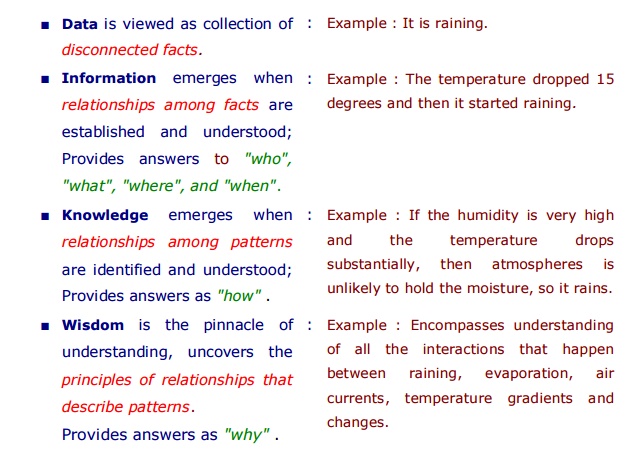
knowledge model
A knowledge model tells, that as the degree of “connectedness” and “understanding” increases, we progress from data through information and knowledge to wisdom.
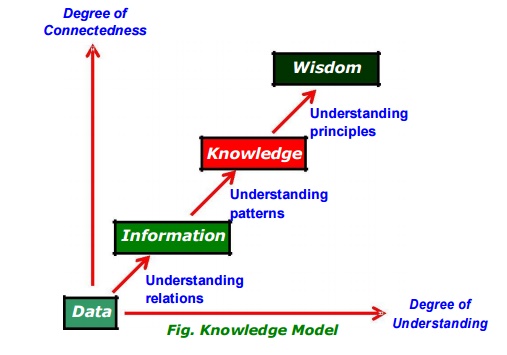
The model represents transitions and understanding.
the transitions are from data, to information, to knowledge, and finally to wisdom;
the understanding support the transitions from one stage to the next stage.
The distinctions between data, information, knowledge, and wisdom are not very discrete. They are more like shades of gray, rather than black and white (Shedroff, 2001).
"data" and "information" deal with the past; they are based on the gathering of facts and adding context.
"knowledge" deals with the present that enable us to perform.
"wisdom" deals with the future, acquire vision for what will be, rather than for what is or was.
Knowledge Category
.
Knowledge is categorized into two major types: Tacit and Explicit.
term “Tacit” corresponds to "informal" or "implicit" type of knowledge, term “Explicit” corresponds to "formal" type of knowledge.
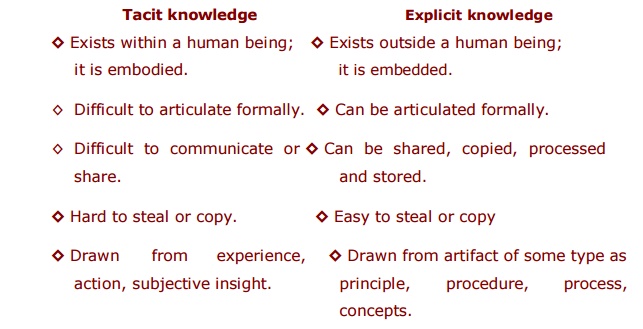
â– Knowledge Typology Map
The map shows two types of knowledge - Tacit and Explicit knowledge.
Tacit knowledge comes from "experience", "action", "subjective" , "insight" Explicit knowledge comes from "principle", "procedure", "process",
"concepts", via transcribed content or artifact of some type.
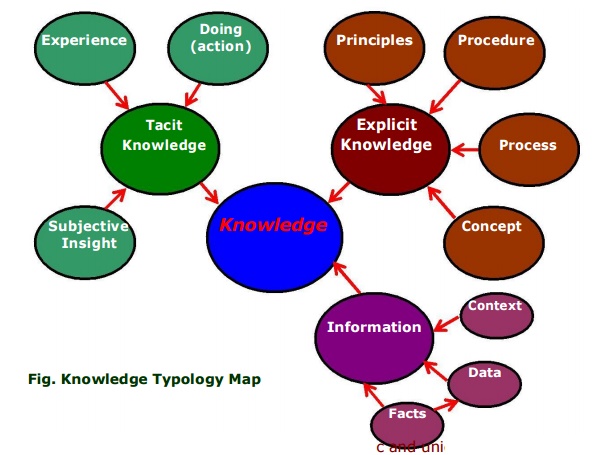
Facts : are data or instance that are specific and unique.
Concepts : are class of items, words, or ideas that are known by a common name and share common features.
Processes : are flow of events or activities that describe how things work rather than how to do things.
Procedures : are series of step-by-step actions and decisions that result in the achievement of a task.
Principles : are guidelines, rules, and parameters that govern; principles allow to make predictions and draw implications;
These artifacts are used in the knowledge creation process to create two types of knowledge: declarative and procedural explained below.
Knowledge Type
Cognitive psychologists sort knowledge into Declarative and Procedural category and some resea hers added Strategic as a third category.
About procedural knowledge, there is some disparity in views.
One, it is close to Tacit knowledge, it manifests itself in the doing of some-thing yet cannot be expressed in words; e.g., we read faces and moods.
Another, it is close to declarative knowledge; the difference is that a task or method is described instead of facts or things.
All declarative knowledge are explicit knowledge; it is knowledge that can be and has been articulated.
The strategic knowledge is thought as a subset of declarative knowledge.
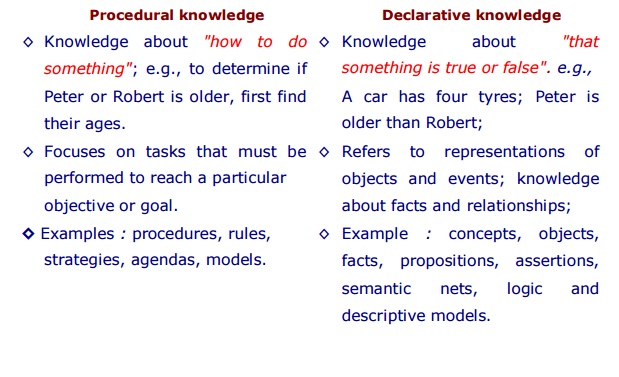
The relationship among explicit, implicit, tacit, declarative and procedural
knowledge are illustrated below.
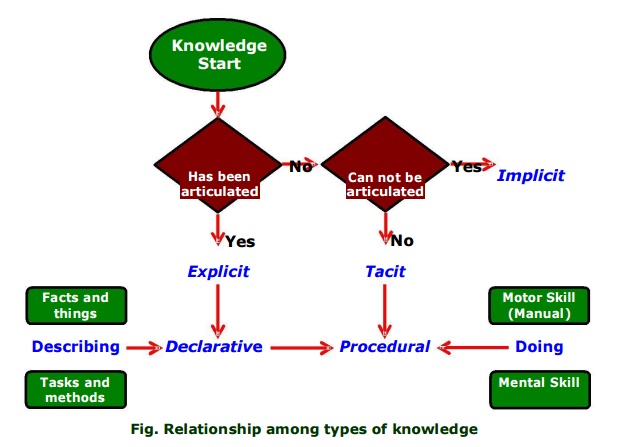
The Figure shows :
Declarative knowledge is tied to "describing" and
Procedural knowledge is tied to "doing."
Vertical arrows connecting explicit with declarative and tacit with procedural, indicate the strong relationships exist among them.
Horizontal arrow connecting declarative and procedural indicates that we often develop procedural knowledge as a result of starting with declarative knowledge. i.e., we often "know about" before we "know how".
Therefore, we may view :
all procedural knowledge as tacit knowledge, and
all declarative knowledge as explicit knowledge.
Related Topics